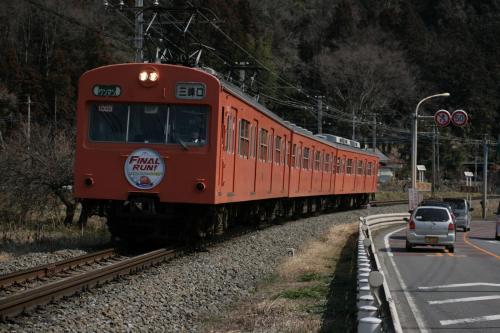
|
|
|
テーマ:鉄道(21871)
カテゴリ:鉄道ミニエッセイ
 2014(平成26)年3月に引退する秩父鉄道1000系電車は、元国鉄101系電車である。今回は戦後昭和の日本の通勤電車の新時代を切り開いた101系電車の歴史を紐解いていく。 101系電車は1957(昭和32)年に登場した、国鉄初の「新性能電車」。 戦後の復興とその後の高度経済成長により、東京や大阪といった大都市圏で年々急増する国鉄電車の通勤輸送、特に中央線快速などの都心から郊外方面へとつながる路線において、需要に追い付くことができず、大きな改良を迫られていた。そこで「スピードが速く、乗り心地がよく、しかも性能のより高い電車」として1956(昭和31)年に計画された車両が101系である。カルダン駆動方式の採用など、旧来の車両とは抜本的に構造や性能が異なることから、「新性能電車」と呼ばれるようになった。塗装は「朱色1号」と呼ばれるオレンジバーミリオンとなり、「ぶどう色2号」の省線電車とは一線を画した。中央線快速=オレンジ色というイメージを作り出した車両こそ、この101系だったのだ。 101系は当初、6両編成の基本編成と4両編成の付属編成の組み合わせで登場。10両全てがモーター付きの車両で加減速性能を向上させ、運行時分の短縮による輸送力増強を狙っていた。しかし101系に思わぬ不運がやってくる。10両全てをモーター付きとしたために、使用電力が変電所の限界を超えてしまうことが解り、性能を落としての運行を余儀なくされた。試験走行の結果、10両編成組成時で、10両全てモーター付きから、モーター付き6両、モーターなし4両(6M4T)に編成を組み替えることになった。 その後は中央線快速をはじめ、大阪環状線、山手線(当時の車体色は黄緑色ではなくカナリヤ色)、中央・総武緩行線、京浜東北線、南武線、関西本線、片町線、桜島線、鶴見線、仙石線で活躍した。 1980年代に入ると、201系や205系などの新型車両に置き換えられ、国電においては、中央線快速からは1985(昭和60)年、中央・総武緩行線からはJR化後の1988(昭和63)年に姿を消した。国電以外でも、南武線川崎~立川間で1991(平成3)年に、桜島線と鶴見線で1992(平成4)年に姿を消した。最後まで101系が残っていた南武線尻手~浜川崎間(浜川崎線)からも2003(平成15)年に姿を消し、国鉄・JRから101系が全て消えた。 2007(平成19)年よりクモハ101-902が埼玉県・大宮の鉄道博物館にて展示されている。  鉄道博物館に展示されているクモハ101-902 Kumoha 101-902 displayed in the Japan Railway Museum 1985(昭和60)年からJR化後の1989(平成元)年にかけて、習志野電車区に所属していた車両を中心に、3両編成12本の36両が秩父鉄道へ譲渡され、同社では1000系を名乗っている。結果として、秩父鉄道1000系が最後まで残った101系となった。秩父鉄道1000系が注目されるきっかけとなったできごとが、前述のクモハ101-902の鉄道博物館での展示である。この直前より、「動く」101系が、博物館と同じ埼玉県内で見られる・乗れることを売りに、1000系の一部に国鉄時代に見られたオレンジバーミリオン、スカイブルー、カナリヤ色、黄緑色+前面黄色帯の各塗装が復活した。 しかしこの時すでに新造から40年以上を経て老朽化が進んでおり、2009(平成21)年より東急電鉄から移籍してきた8500系(秩父鉄道7000系)と8090系(同7500系)に置き換えられることとなり、1000系の廃車が始まった。2014(平成26)年3月、国鉄101系の伝統色であるオレンジバーミリオン塗装を復活させた1003Fが、最後の最後まで現役で残った国鉄101系となった。 1003Fの引退により、国鉄101系電車57年の歴史に幕が下りた。 参考文献:鉄道ピクトリアル 2013年4月号 特集「101系電車」 Chichibu Railway 1000 Series, retiring on this March, is old Japan National Railway 101 Series. This blog covers the historical commuter train, 101 Series. 101 Series debuted in 1957 to solve the crowd, becoming more terrible as time went by, on the railway connecting metropolitan area and its suburb, such as Chuo Line. Its concept was "faster, more comfortable, and higher specification". Because of its innovation adoption such as cardan drive device, 101 Series was called "New Specification Units". The body was wholly painted orange, which was different from the older units and became the symbol colour of Chuo Line rapid service. The first set of 101 Series was made with 10 carriages (6+4, including 4 cab carriages), all of which were motored to improve the running performance to shorten the travellng time. However, an unluckiness struck; electric power substations couldn't supply enough electricity for 101 Series to show its ability to the fullest because of 10 motored carriages, so it had to slow down the performance. In consequence of result of the test run, 101 was rearranged the set to the one with 6 motered carriages when it consisted of a 10-carriage set. Then 101 Series spread to many lines in Tokyo and Osaka metropolitan area, such as Osaka Loop, Yamanote (yellow coloured on that time), Chuo Sobu local service, Keihin-tohoku, Nanbu, Kansai, Katamachi, Sakurajima, Tsurumi, and Senseki Lines. In 1980s, 101 Series started to be replaced by 201 Series and 205 Series. On railways in metropolitan area it retied from Chuo Line rapid service in 1985 and from Chuo Sobu Line local service in 1988 after National Railway's privatization. On other lines it did from Nanbu Line (Kawasaki - Tachikawa) in 1991 and from Sakurajima and Tsurumi Lines in 1992. The last remaining ones on Nanbu Line (Shitte - Hama-kawasaki) retired in 2003. From 2007 a cab carriage, Kumoha 101-902 in the first-made set displayed at the Japan Railway Museum in Omiya, Saitama Prefecture. 12 sets of 101 Series, rearranged to 3-carriage, had moved to Chichibu Railway between 1985 and 1989, where it was renamed 1000 Series. As a result of the retirement from JR, they became the last remaining 101 Series. What cast a spotlight on 1000 Series was the regular exhibition on Kumoha 101-902 at the Japan Railway Museum. Since just before the museum's open 4 sets were repainted to the one in the JNR period, orange on Chuo Line rapid service, yellow on Chuo Sobu Line local service, light blue on Keihin-tohoku Line, and light green with yellow line on the front on Kansai Line and Chichibu Railway had sold itself as where JNR 101 Series regularly run. However, on that time, most of 1000 Series had passed over 40 years since their manufacture, so they started to be replaced by 8500 Series and 8090 Series from Tokyu Corporation (renamed 7000 and 7500). 1003F set, which was repainted to orange, the traditional colour of 101 Series since its debut, became the last remaining JNR 101 Series in a real sense. Reference: Railway Pictorial April 2013 issue "101 Series" お気に入りの記事を「いいね!」で応援しよう
最終更新日
Mar 16, 2014 09:02:56 PM
コメント(0) | コメントを書く
[鉄道ミニエッセイ] カテゴリの最新記事
|